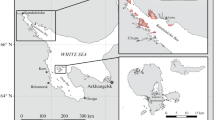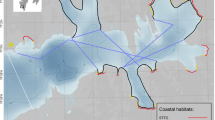Abstract
Seabirds were counted from ships on 300 m wide transects in the southeastern North Sea between April and July 1993. For some species the numbers off the coast and off the Waddensea area could be estimated. Gannet (Morus bassanus, 800 individuals), Fulmar (Fulmarus glacialis, 8000 ind.), Kittiwake (Rissa tridactyla, 4200 ind.) and Common Guillemot (Uria aalge, 3100 ind.) occurred with few exceptions only in the vicinity of the breeding site on Helgoland and further towards the open sea. Lesser Black-backed Gull (Larus fuscus, 25000 ind.) and Herring Gull (Larus argentatus, 2100 ind.) were widely distributed: Lesser Black-backed Gulls concentrated in larger distances from the coast than Herring Gulls did. They were found in high densities above all near trawlers. Great Black-backed Gulls (Larus marinus, 1200 ind.) were seen regularly but always in low numbers in the southeastern part of the study area. Common Gull (Larus canus) and Black-headed Gull (Larus ridibundus) were observed almost exclusively in the Wadden Sea but in sometimes remarkably high densities. Common Terns (Sterna hirundo) were more or less confined to the area of their breeding colonies whereas Sandwich Terns (Sterna sandvicensis) were also found further out to the sea.
Zusammenfassung
Von April bis Juli 1993 wurden in der südöstlichen Nordsee von Schiffen aus auf 300 m breiten Transekten Seevögel kartiert. Dabei konnte für einige Arten der Bestand abseits des Wattenmeeres und der Küste hinlänglich genau geschätzt werden. Baßtölpel (800 Ind.), Eissturmvogel (8000 Ind.), Dreizehenmöwe (4200 Ind.) und Trottellumme (3100 Ind.) kamen fast ausschließlich in der Nähe des Brutplatzes Helgoland und weiter seewärts vor. Herings- (25 000 Ind.) und Silbermöwe (2100 Ind.) waren weit verbreitet; die Heringsmöwe konzentrierte sich weiter entfernt von der Küste als die Silbermöwe und trat in hohen Dichten vor allem in der Nähe von Fischkuttern auf. Mantelmöwen (1200 Ind.) wurden vor allem im Südosten des Untersuchungsgebietes regelmäßig, aber in stets geringer Anzahl festgestellt. Sturm- und Lachmöwe wurden fast nur im Wattenmeer in allerdings oftmals hoher Dichte registriert. Die Flußseeschwalbe war stark an die Kolonien nahe der Küste gebunden, während die Brandseeschwalbe auch weiter auf See beobachtet wurde.
Similar content being viewed by others
Literatur
Becker, P. H., &M. Erdelen (1987): Die Bestandsentwicklung von Brutvögeln der deutschen Nordseeküste 1950–1979. J. Orn. 128: 1–32.
Behm-Berkelmann, K., &H. Heckenroth (1991): Übersicht der Brutbestandsentwicklung ausgewählter Vogelarten 1900–1990 an der niedersächsischer Nordseeküste. Naturschutz Landschaftspfl. Niedersachsen 27.
Busche, G., &R. K. Berndt (1981): Ornithologischer Jahresbericht für Schleswig-Holstein 1978. Corax 8: 166–196.
Camphuysen, C. J. (1993): Fourageermogelijkheden voor zeevogels in de boomkorvisserij: een verkennend onderzoek. Sula 7: 81–104.
Ders. (1994): Flatfish selection by Herring GullsLarus argentatus and Lesser Black-backed GullsLarus fuscus scavenging at commercial beamtrawlers in the southern North Sea. Neth. J. Sea Res. 32: 91–98.
Ders.,K. Ensor, R. W. Furness, S. Garthe, O. Hüppop, G. Leaper, H. Offringa &M. L. Tasker (1993): Seabirds feeding on discards in winter in the North Sea. EC DG XIV research contract 92/3505. NIOZ-rapport 1993–8, Neth. Inst. Sea Res., Texel.
Carter, I. C., J. M. Williams, A. Webb &M. L. Tasker (1993): Seabird concentrations in the North Sea: an atlas of vulnerability to surface pollutants. Joint Nature Cons. Comm., Aberdeen.
Dierschke, J., V. Dierschke, D. Moritz, U. Nettelmann &F. Stühmer (1994): Ornithologischer Jahresbericht 1993 für Helgoland. Orn. Jber. Helgoland 4: 1–62.
Garthe, S. (1993): Quantifizierung von Abfall und Beifang der Fischerei in der südöstlichen Nordsee und deren Nutzung durch Seevögel. Hamburger avifaun. Beitr. 25: 125–237.
Ders. &O. Hüppop (1994): Distribution of ship-following seabirds and their utilization of discards in the North Sea in summer. Mar. Ecol. Prog. Ser. 106: 1–9.
Gloe, P. (1982): Vogelbeobachtungen am 6. und 13. Mai 1978 zwischen Büsum and Helgoland. Corax 9: 38–45.
Goethe, F. (1970): Märzaspekt des Vogellebens in der südlichen Nordsee. Ber. Dtsch. wiss. Komm. Meeresforsch. 21: 430–443.
Grunsky, B. (1994): Trottellummen (Uria aalge) in der Brutkolonie auf Helgoland: Anwesenheitsmuster der Altvögel, Bestand und Nahrungsökologie der Jungen. Acta ornithoecol. 3: 33–45.
Haney, J. C., &A. R. Solow (1992): Analyzing quantitative relationships between seabirds and marine resource patches. Curr. Orn. 9: 105–161.
Helbig, A., V. Riehl &J. Voss (1979): Ornithologische Beobachtungen im Frühjahr 1977 auf der Forschungsplattform „Nordsee“. Abh. Geb. Vogelkde. 6: 215–247.
Hunt, G. L., Jr., &D. C. Schneider (1987): Scale-dependent processes in the physical and biological environment of marine birds. In:J. P. Croxall, Seabirds: feeding ecology and role in marine ecosystems. Cambridge: 7–41.
Kuschert, H., &H. Witt (1985): Ergebnisse der Mantel- und Silbermöwenzählungen (Larus marinus undL. argentatus) auf Helgoland 1971 bis 1979 — ein Beitrag zum Jahreszyklus dieser Arten in der Deutschen Bucht. Seevögel 6, Sonderbd.: 133–136.
Leopold, M. F., P. A. Wolf &O. Hüppop (1992): Food of young and colony-attendance of adult GuillemotsUria aalge on Helgoland. Helgoländer Meeresunters. 46: 237–249.
Lozán, J. L., E. Rachor, K. Reise, H. von Westernhagen &W. Lenz (1994): Warnsignale aus dem Wattenmeer. Wissenschaftliche Fakten. Berlin.
Prüter, J. (1985): Zur Art-, Alters- und Geschlechtszusammensetzung der Großmöwenbestände auf Helgoland. Seevögel 6, Sonderbd.: 137–140.
Prüter, J. (1986): Das Vorkommen der häufigen Möwenarten (Laridae) im Seegebiet der Deutschen Bucht — Ergebnisse mehrjähriger Planbeobachtungen auf der Forschungsplattform „Nordsee“: Seevögel: 7: 13–20.
Ritzel, L. (1978): Günstige Möglichkeit zur Seevogelbeobachtung bleibt weitgehend ungenutzt. Vogelkdl. Ber. Niedersachsen 10: 45–47.
Schmid, U. (1988): Vogelinsel Scharhörn. Europareservat im Elbe-Weser-Dreieck. Niederelbe-Verlag H. Huster, Otterndorf.
Schneider, D. C. (1992): Scale-dependent spatial dynamics: marine birds in the Bering Sea. Biol. Rev. 68: 579–598.
Südbeck, P., &B. Hälterlein (1994): Brutvogelbestände an der deutschen Nordseeküste im Jahre 1992 — Sechste Erfassung durch die Arbeitsgemeinschaft „Seevogelschutz“. Seevögel 14: 11–15.
Tasker, M. L., P. H. Jones, T. J. Dixon, &B. F. Blake (1984): Counting seabirds at sea from ships: a review of methods employed and a suggestion for a standardized approach. Auk 101: 567–577.
Tasker, M. L., A. Webb, A. J. Hall, M. W. Pienkowski, &D. R. Langslow (1987): Seabirds in the North Sea. Final report of phase 2 of the Nature Conservancy Council Seabirds at Sea Project November 1983–October 1986. Nature Conservancy Council, Peterborough.
Temme, M. (1989): Über das Vorkommen von See- und Hochseevogelarten vor der Insel Norderney nach Planbeobachtungen. Vogelkdl. Ber. Niedersachsen 21: 54–63.
Walter, U., &P. H. Becker (1994): The significance of discards from the Brown Shrimp fisheries for seabirds in the Wadden Sea — preliminary results. Ophelia Suppl. 6: 253–262.
Webb, A., M. L. Tasker &S. P. R. Greenstreet (1985): The distribution of Guillemots (Uria aalge), Razorbills (Alca torda), and Puffins (Fratercula arctica) at sea around Flamborough Head, June 1984. NCC rep. 590. Nature Conservancy Council, Aberdeen.
Author information
Authors and Affiliations
Rights and permissions
About this article
Cite this article
Garthe, S., Alicki, K., Hüppop, O. et al. Die Verbreitung und Häufigkeit ausgewählter See- und Küstenvogelarten während der Brutzeit in der südöstlichen Nordsee. J Ornithol 136, 253–266 (1995). https://doi.org/10.1007/BF01651292
Published:
Issue Date:
DOI: https://doi.org/10.1007/BF01651292




